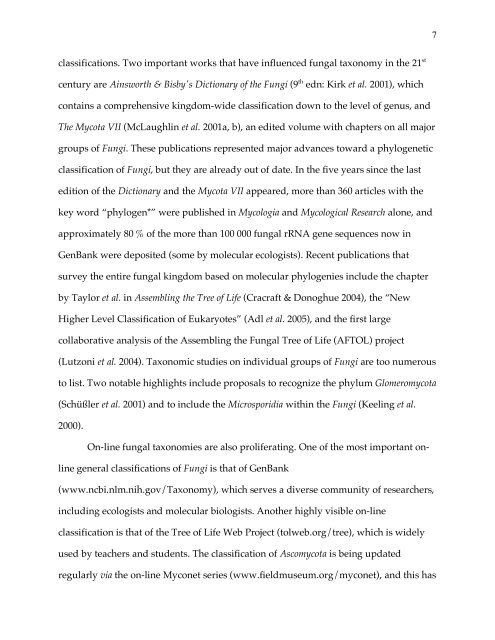Elsevier Editorial System(tm) for Mycological ... - Clark University
Elsevier Editorial System(tm) for Mycological ... - Clark University
Elsevier Editorial System(tm) for Mycological ... - Clark University
You also want an ePaper? Increase the reach of your titles
YUMPU automatically turns print PDFs into web optimized ePapers that Google loves.
classifications. Two important works that have influenced fungal taxonomy in the 21 st<br />
century are Ainsworth & Bisby's Dictionary of the Fungi (9 th edn: Kirk et al. 2001), which<br />
contains a comprehensive kingdom-wide classification down to the level of genus, and<br />
The Mycota VII (McLaughlin et al. 2001a, b), an edited volume with chapters on all major<br />
groups of Fungi. These publications represented major advances toward a phylogenetic<br />
classification of Fungi, but they are already out of date. In the five years since the last<br />
edition of the Dictionary and the Mycota VII appeared, more than 360 articles with the<br />
key word “phylogen*” were published in Mycologia and <strong>Mycological</strong> Research alone, and<br />
approximately 80 % of the more than 100 000 fungal rRNA gene sequences now in<br />
GenBank were deposited (some by molecular ecologists). Recent publications that<br />
survey the entire fungal kingdom based on molecular phylogenies include the chapter<br />
by Taylor et al. in Assembling the Tree of Life (Cracraft & Donoghue 2004), the “New<br />
Higher Level Classification of Eukaryotes” (Adl et al. 2005), and the first large<br />
collaborative analysis of the Assembling the Fungal Tree of Life (AFTOL) project<br />
(Lutzoni et al. 2004). Taxonomic studies on individual groups of Fungi are too numerous<br />
to list. Two notable highlights include proposals to recognize the phylum Glomeromycota<br />
(Schüßler et al. 2001) and to include the Microsporidia within the Fungi (Keeling et al.<br />
2000).<br />
On-line fungal taxonomies are also proliferating. One of the most important on-<br />
line general classifications of Fungi is that of GenBank<br />
(www.ncbi.nlm.nih.gov/Taxonomy), which serves a diverse community of researchers,<br />
including ecologists and molecular biologists. Another highly visible on-line<br />
classification is that of the Tree of Life Web Project (tolweb.org/tree), which is widely<br />
used by teachers and students. The classification of Ascomycota is being updated<br />
regularly via the on-line Myconet series (www.fieldmuseum.org/myconet), and this has<br />
7
















